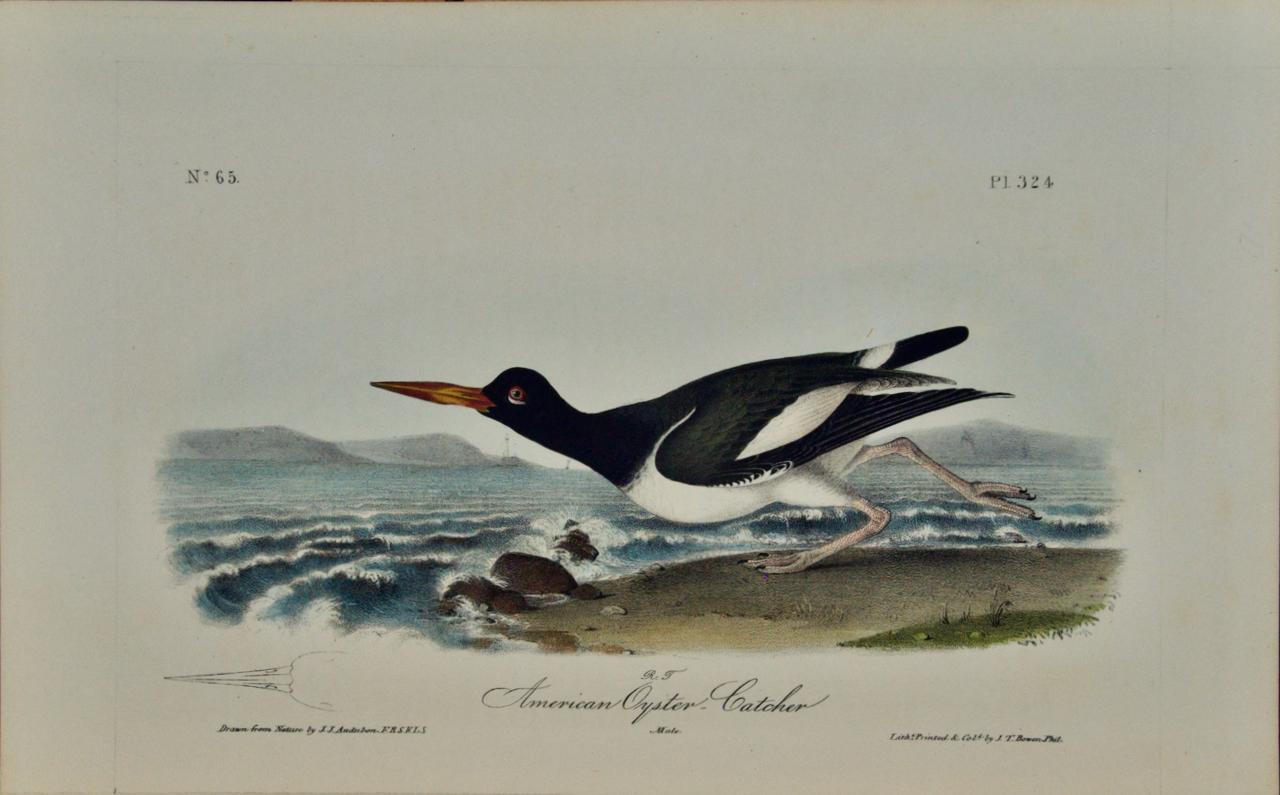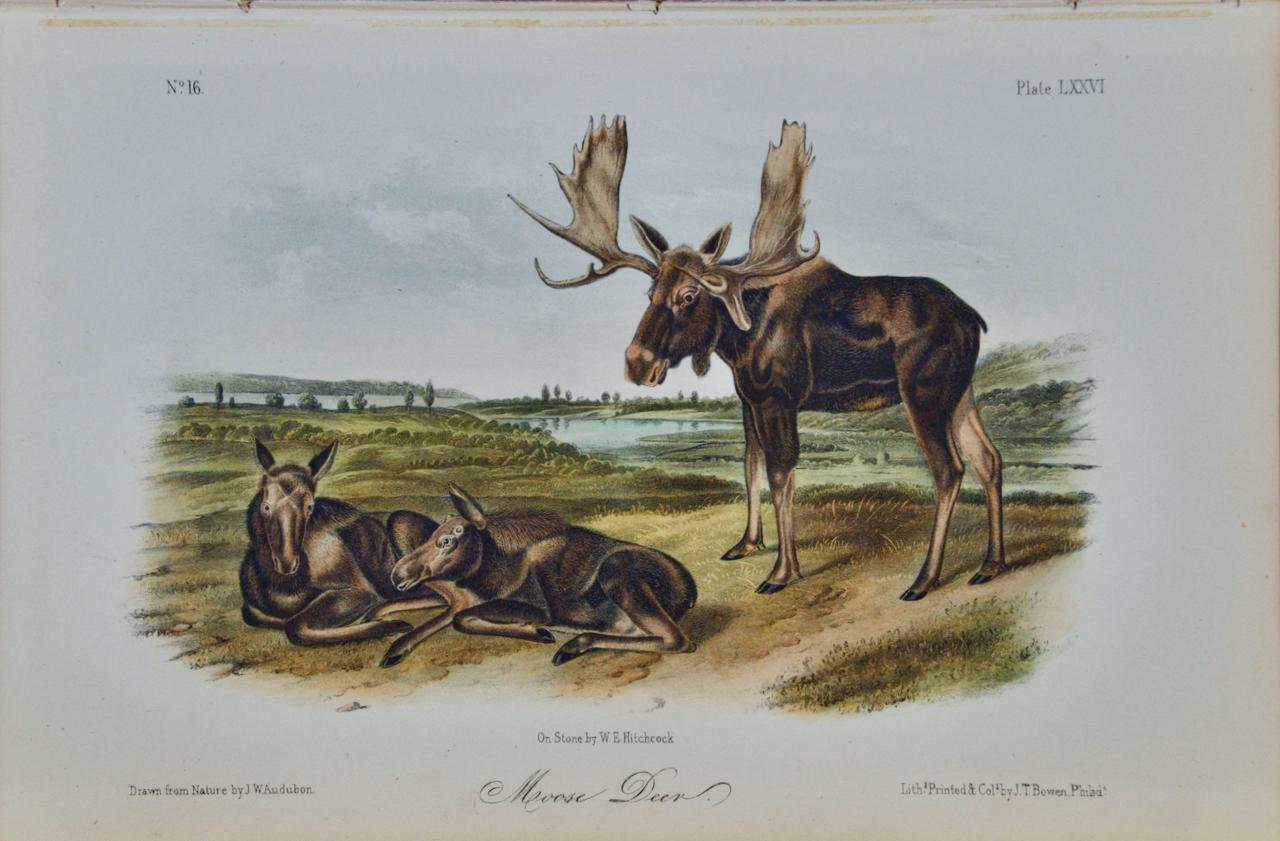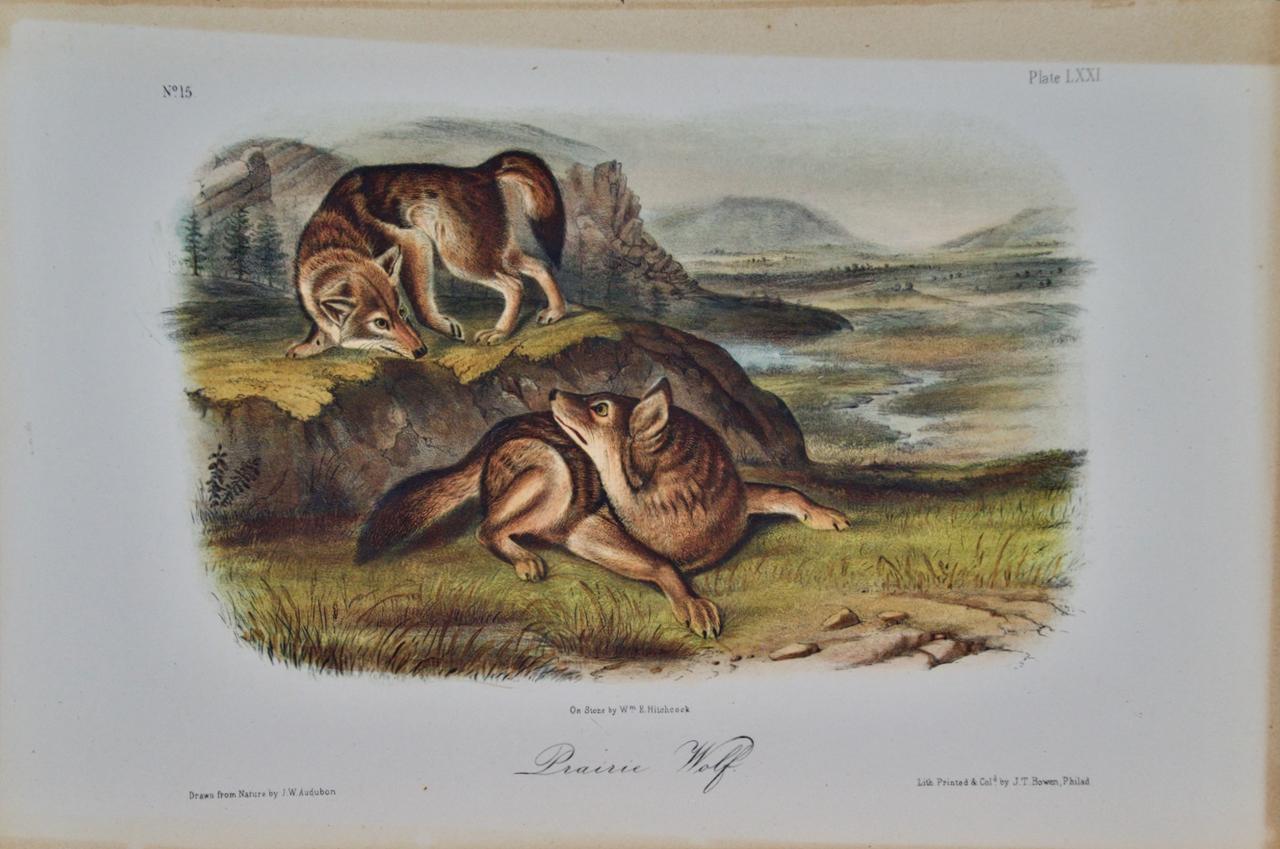Items Similar to Blue-eyed Cockatoo: A Framed Original 19th C. Hand-colored Lithograph by Gould
Want more images or videos?
Request additional images or videos from the seller
1 of 9
John Gould and Henry Constantine RichterBlue-eyed Cockatoo: A Framed Original 19th C. Hand-colored Lithograph by Gould1851-1869
1851-1869
About the Item
This is a framed original 19th century hand-colored folio-sized lithograph entitled “Cacatua Ophthalimica” (Blue-eyed Cockatoo) by John Gould, from the supplement to his "Birds of Australia", published in London between 1851 and 1869. The print depicts a large blue-eyed cockatoo perched on a branch, with its head turned to the left. The scene is enhanced with leaves and sky and clouds in the background.
This striking framed Gould hand-colored lithograph is presented in an antiqued gold-colored wood frame and a cream-colored French mat with a prominent beige-colored band. The frame measures 33" high, 25.5" wide and 1.25." thick. The print and frame are in excellent condition
There are several other framed and unframed Gould bird lithographs available on our 1stdibs and InCollect storefronts. Two or more of these striking lithographs would make an attractive display grouping. A discount is available for purchase of a set depending on the number. These additional Gould hummingbirds may be viewed by typing Timeless Intaglio in the 1stdibs or InCollect search field to be taken to our storefront.
John Gould (1804-1881]) was an English ornithologist and artist. He, like his American contemporary John James Audubon, published a number of books on birds in the mid 19th century, illustrated by hand-colored lithographs. His wife and fellow artist, Elizabeth Gould, and several other artists including Edward Lear and Henry Constantine Richter produced lithographs for his various publications. He has been considered the father of bird study in Australia and the Gould League in Australia is named after him. Charles Darwin referenced Gould’s work in his book, "On the Origin of Species" and Gould named a bird after Darwin; "Darwin's finches".
Gould began his career in London as a taxidermist, but in 1827 became the first curator and conservator at the museum of the Zoological Society of London. In this position naturalists brought him collections of birds from all over the world. He began creating drawings and eventually hand-colored lithographs with his wife and Edward Lear, which were the basis for his first publications. Darwin brought him specimens from the Galapagos Islands, including 12 species of finches which had never been described. In 1838, Gould and his wife travelled to Australia and their work led to the seven volume publication of “The Birds of Australia”. Gould had a fascination for hummingbirds and collected specimens of 320 varieties before ever seeing a live hummingbird on a trip to the United States in 1857. He eventually published “A Monograph of the Trochilidae, or Family of Humming-birds". Other large publications include: "The Birds of Europe"," A Monograph of the Ramphastidae, or Family of Toucans”, “A Synopsis of the Birds of Australia, and the Adjacent Islands”, “A Monograph of the Odontophorinae, or Partridges of America”, “The Birds of Asia”, “The Birds of Great Britain” and "The Birds of New Guinea and the Adjacent Papuan Islands, including many new species recently discovered in Australia".
John Gould (1804-1881) was a British ornithologist and illustrator who is best known for his monumental work, "The Birds of Europe," published between 1832 and 1837. Gould was born in Lyme Regis, Dorset, England, and began working as a taxidermist and natural history dealer in London in the 1820s. In 1827, Gould was appointed the first curator and preserver of birds at the Zoological Society of London, where he began to build his collection of specimens and began to study the birds of the world. He published his first monograph, "A Century of Birds from the Himalaya Mountains," in 1831, which included 80 plates of Himalayan birds. Gould continued to publish numerous volumes on the birds of the world throughout his life, including "The Birds of Australia" (1840-1848) and "The Birds of Great Britain" (1862-1873). His works were highly regarded for their accuracy and detail, and he was one of the most prominent ornithologists of his time.
In addition to his work as an ornithologist, Gould was also a successful businessman, and he used his profits to fund expeditions and to support the scientific community. He was elected a Fellow of the Royal Society in 1843, and he was awarded the Royal Medal in 1844 and the Gold Medal of the Zoological Society in 1856. John Gould died in London in 1881 at the age of 76. He is remembered as one of the greatest ornithologists of the 19th century and as a pioneer of the scientific study of birds.
- Creator:John Gould and Henry Constantine Richter (1804 - 1881, English)
- Creation Year:1851-1869
- Dimensions:Height: 33 in (83.82 cm)Width: 25.5 in (64.77 cm)
- Medium:
- Movement & Style:
- Period:
- Condition:
- Gallery Location:Alamo, CA
- Reference Number:
John Gould and Henry Constantine Richter
John Gould (1804-1881]) was an English ornithologist and artist. He, like his American contemporary John James Audubon, published a number of books on birds in the mid 19th century, illustrated by hand-colored lithographs. His wife and fellow artist, Elizabeth Gould, and several other artists including Edward Lear and Henry Constantine Richter produced lithographs for his various publications. He has been considered the father of bird study in Australia and the Gould League in Australia is named after him. Charles Darwin referenced Gould’s work in his book, "On the Origin of Species" and Gould named a bird after Darwin; "Darwin's finches". Gould began his career in London as a taxidermist, but in 1827 became the first curator and conservator at the museum of the Zoological Society of London. In this position naturalists brought him collections of birds from all over the world. He began creating drawings and eventually hand-colored lithographs with his wife and Edward Lear, which were the basis for his first publications. Darwin brought him specimens from the Galapagos Islands, including 12 species of finches which had never been described. In 1838, Gould and his wife travelled to Australia and their work led to the seven volume publication of “The Birds of Australia”. Gould had a fascination for hummingbirds and collected specimens of 320 varieties before ever seeing a live hummingbird on a trip to the United States in 1857. He eventually published “A Monograph of the Trochilidae, or Family of Humming-birds". Other large publications include: "The Birds of Europe"," A Monograph of the Ramphastidae, or Family of Toucans”, “A Synopsis of the Birds of Australia, and the Adjacent Islands”, “A Monograph of the Odontophorinae, or Partridges of America”, “The Birds of Asia”, “The Birds of Great Britain” and "The Birds of New Guinea and the Adjacent Papuan Islands, including many new species recently discovered in Australia".
About the Seller
5.0
Gold Seller
These expertly vetted sellers are highly rated and consistently exceed customer expectations.
Established in 2011
1stDibs seller since 2019
242 sales on 1stDibs
Typical response time: 1 hour
- ShippingRetrieving quote...Ships From: Alamo, CA
- Return PolicyA return for this item may be initiated within 7 days of delivery.
More From This SellerView All
- "Washington Sea Eagle": An Original Audubon Hand-colored LithographBy After John James AudubonLocated in Alamo, CAThis is an original John James Audubon hand-colored royal octavo lithograph entitled "Washington Sea Eagle", No. 3, Plate 13, from Audubon's "Birds of America". It was lithographed, printed and colored by J. T. Bowen and published in Philadelphia between 1856-1871. It depicts an adult male sea eagle perched on a rock. This is an excerpt from Audubon's own description of this magnificent eagle, which includes how he came up with the name "Washington Sea Eagle": "The name which I have chosen for this new species of Eagle, “The Bird of Washington,” may, by some, be considered as preposterous and unfit; but as it is indisputably the noblest bird of its genus that has yet been discovered in the United States, I trust I shall be allowed to honour it with the name of one yet nobler, who was the saviour of his country, and whose name will ever be dear, to it. To those who may be curious to know my reasons, I can only say, that, as the new world gave me birth and liberty, the great man who ensured its independence is next to my heart. He had a nobility of mind, and a generosity of soul, such as are seldom possessed. He was brave, so is the Eagle; like it, too, he was the terror of his foes; and his fame, extending from pole to pole, resembles the majestic soarings of the mightiest of the feathered tribe...Category
Mid-19th Century Naturalistic Animal Prints
MaterialsLithograph
- "American Oyster Catcher": An Original Audubon Hand-colored LithographBy After John James AudubonLocated in Alamo, CAThis is an original first octavo edition John James Audubon hand-colored royal octavo lithograph entitled "American Oyster Catcher, Male", No. 65, Plate...Category
Mid-19th Century Naturalistic Animal Prints
MaterialsLithograph
- "King Duck": An Original First Octavo Edition Audubon Hand-colored LithographBy John James AudubonLocated in Alamo, CAThis is an original John James Audubon hand-colored royal first octavo edition lithograph entitled "King Duck, 1. Male, 2. Female", No. 81, Plate 404, from A...Category
Mid-19th Century Naturalistic Animal Prints
MaterialsLithograph
- "Moose Deer", an Original 19th C. Audubon Hand-colored Quadruped LithographBy John James AudubonLocated in Alamo, CAThis is an original John James Audubon hand-colored royal octavo lithograph entitled "Moose Deer, Male", No. 16, Plate 76 from Audubon's "Quadrupeds of North America". It was drawn on stone by William Hitchcock, printed and colored by J. T. Bowen and published in 1849-1854. It depicts a male moose standing on grass on the right with two female moose...Category
Mid-19th Century Naturalistic Animal Prints
MaterialsLithograph
- "Red Texan Wolf", an Original 19th C. Audubon Hand-colored Quadruped LithographBy John James AudubonLocated in Alamo, CAThis is an original John James Audubon hand-colored royal octavo lithograph entitled "Red Texan Wolf", No. 17, Plate 82 from Audubon's "Quadrupeds of North America". It was drawn on ...Category
Mid-19th Century Naturalistic Animal Prints
MaterialsLithograph
- "Prairie Wolf": An Original Audubon 19th Century Hand-colored LithographBy John James AudubonLocated in Alamo, CAThis is an original John James Audubon hand-colored royal octavo lithograph entitled "Prairie Wolf", No. 15, Plate LXXI, 71 from Audubon's "Quadrupeds of North America". It was drawn...Category
Mid-19th Century Naturalistic Animal Prints
MaterialsLithograph
You May Also Like
- Dalmation & Bull TerrierLocated in Columbia, MODalmation & Bull Terrier 1883-84 Chromolithograph 8.5 x 11 inchesCategory
1880s Naturalistic Animal Prints
MaterialsLithograph
- DachsundsLocated in Columbia, MODachsunds 1883-84 Chromolithograph 8.5 x 11 inchesCategory
1880s Naturalistic Animal Prints
MaterialsLithograph
- Terriers No. 2Located in Columbia, MOTerriers No. 2 1883-84 Chromolithograph 8.5 x 11 inchesCategory
1880s Naturalistic Animal Prints
MaterialsLithograph
- Terriers No. 1Located in Columbia, MOTerriers No. 1 1883-84 Chromolithograph 8.5 x 11 inchesCategory
1880s Naturalistic Animal Prints
MaterialsLithograph
- Pug, Greyhound, TerrierLocated in Columbia, MOPug, Greyhound, Terrier 1883-84 Chromolithograph 8.5 x 11 inchesCategory
1880s Naturalistic Animal Prints
MaterialsLithograph
- American Crow 1858 Chromolithograph by J.J. Audubon Plate, Julius Bien EditionBy John James AudubonLocated in Paonia, COAmerican Crow by J.J. Audubon from his Birds of America folio shows an adult male crow in a Black Walnut bush with a nest of a Ruby-Throated Hummingbird in a branch below the crow. This original chromolithograph plate no. 226 is in good condition with a repairable water mark in the image on the left side as can be seen in the photos. The ” Birds of America” by John James...Category
1850s Naturalistic Animal Prints
MaterialsLithograph
Recently Viewed
View AllMore Ways To Browse
A Frame
Antique Wood And Gold Frame
Framed Lithograph Set
19th Century Lithograph Framed
Antique Bird Lithographs
19th C French Frame
Eye Cream
Framed Antique Prints Sets
Antique Print With Gold Frame
London 19th Century Lithograph
Blue John Antique
Elizabeth And James
Henry Fielding
Birds Eye Blue
Antique Framed English Print
Himalayan Art
Monumental Antique Frame
English Lithograph Framed






